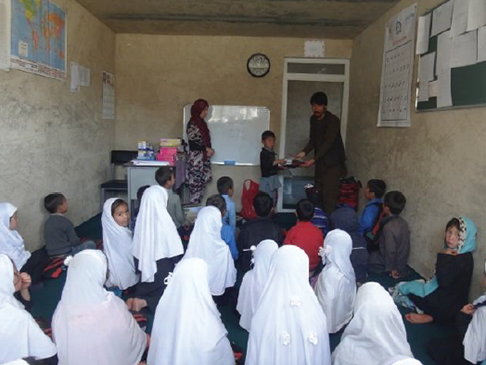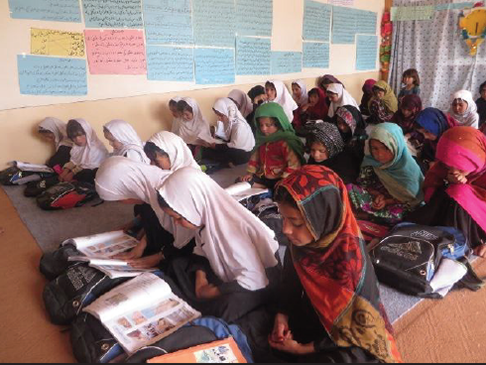Australia is helping Afghanistan to improve service delivery in education by expanding access to schools, improving the quality of education and improving the Afghan Government's capacity to deliver education.
Australia's major bilateral initiatives in education target communities that, due to geographical isolation and conflict, are not reached by Afghan government programs.
The Empowerment Through Education program ($10.6 million 2011-17) is implemented by CARE Australia, filling a critical gap in basic education services across the five provinces of Parwan, Kapisa, Khost, Ghazni and Paktya particularly for girls in remote and rural communities:
- Community-based education classes are held in villages that are beyond the current reach of the Afghan Government's education services.
- Over the life of the program, it will provide community-based education for more than 19,000 students, with a focus on education and leadership for girls, establishing village education committees to increase community/local engagement on education, and recruiting and training teachers.
- The program works closely with the Ministry of Education and follows the national curriculum.
- The program's strong gender focus is increasing the number of girls in primary education, building leadership skills and advocating for the rights of girls and supporting girls social development.
Case Story 1:
Baghaka village is about 8 Km to the east of Gardiz city of Paktya province. More than 60 families live in this village, with more than 80% of the residents living below the poverty line. Agricultural activities and small-enterprises are the main livelihood sources and though some of the Baghaka residents have mid-level education and work in governmental offices. Prior to the EEA-2 project, the closest Secondary school for boys was located 3km away in Baghaka village. As a result of the EEA-2 implementation, younger children, particularly girls, in Baghaka are regularly attending a CBE school with funding support from DAFT. Halima (not her real name), a 2nd grade CBE student, narrates her story on her schooling experience.
"My name is Halima (not her real name to protect her identity), daughter of Gul Aqa. I am eight years old and a2nd grade student in primary school [EEA-2], living in Baghaka village [in Gardiz center of Paktya Province].
I have 3 brothers and 3 sisters. My father, who is illiterate and works as a shopkeeper in our village usually, faces many problems when having to count money and purchase materials from the city. Before [prior to EEA-2], whenever my father wanted to purchase something from the city he would ask the religious leader [Mullah Imam] of our village for help in preparing the list and budget of the materials needed. One day our Mullah Imam left the mosque in our village because of personal problems and my father became so worried that he would no longer be able to run his business without the help of before.
When I started going to class, I studied and studied to help my father with his business in whatever way I could. Thanks to help of my kind teacher who was getting me to read, write, and use numbers by using textbooks, I told my father; "Do not be sad papa. I will help you as Mullah Imam did. My dad looked at me in disbelief and said I was still too young help him. I wanted to prove him wrong so I took a pen and paper and started writing a list of the materials he needed. I then gave him the list but since he couldn't read it, he took the list with him and showed it Wali Khan [a resident of Baghaka who works as an Admin Assistant in Gardiz center of Paktya province] so he could read it to my father. Wali read the list and asked my father who had written it. When my father found out that I had properly written the list, he came to see me right away and congratulated and kissed me with the biggest smile on his face. My father was so happy that he told my mother, brothers and sisters and promised to support me in continuation of my higher education.
I would like express my sincere thanks for the hard work of CARE's EEA-2 project team, VEC members, and all those involved with the effective implementation of this project. Also, I am grateful for the generous support of DAFT for providing educational opportunities for the children in marginalized communities of our country."
Case story 2:
Rawza is a large community of 500 families in Ghazni province. Most of the children in Rawza, especially girls, have very limited access to primary education. The nearest girls school is 5kms away, with the children having to cross dangerous main roads in order to make the journey.
Ayesha (not her real name) is 8 years old girl from this community. 'I love education and I wanted to become a teacher in the future. When I saw my other friends who were going to school I also wanted to go…but due to long distance my family did not allow me. =I became disappointed that I am a girl and could not achieve my dreams.
One day one of VEC members came to my father and told him about CBE classes, he mentioned that these classes are going to be established in our community near our home and that the teachers will also be from the same village. I became happy that my dreams are finally coming true. At night after dinner I was staring to my beloved father's eyes I wished to hear from him that I can attend school. He told me "my dear daughter tomorrow after you finish home chores I will enrol you in school". I thought that my father gave me the whole world - I can't explain my happiness. Now I am studying grade two in a CBE class and I learn reading, writing and many other skills.
Every day I quickly finish household tasks and complete my homework and then with high interest and hope attend my class.
At the end I would like to extend my special thanks to EEA-2 staff for establishing CBE classes in my community and also for DAFT to provide financial support to such important project.


